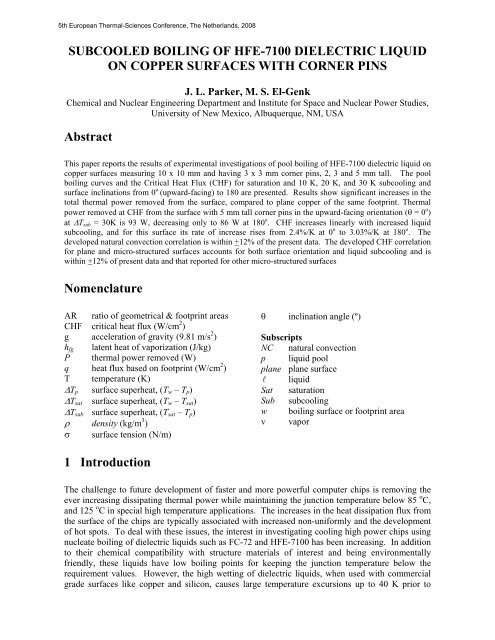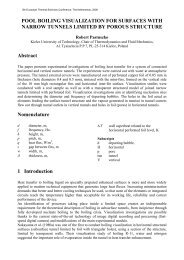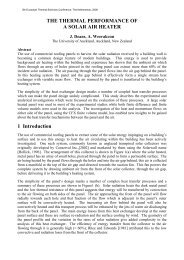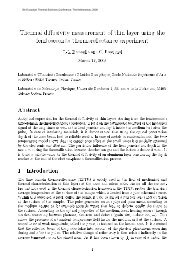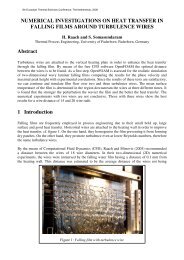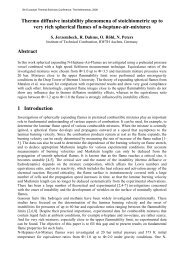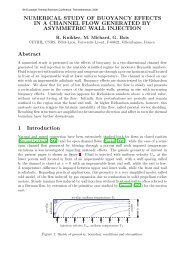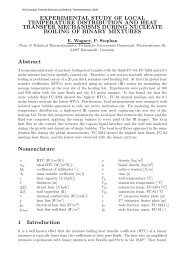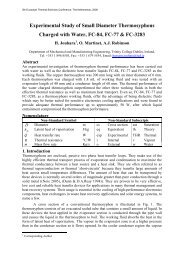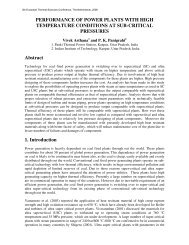SUBCOOLED BOILING OF HFE-7100 ... - Eurotherm 2008
SUBCOOLED BOILING OF HFE-7100 ... - Eurotherm 2008
SUBCOOLED BOILING OF HFE-7100 ... - Eurotherm 2008
You also want an ePaper? Increase the reach of your titles
YUMPU automatically turns print PDFs into web optimized ePapers that Google loves.
5th European Thermal-Sciences Conference, The Netherlands, <strong>2008</strong><br />
<strong>SUBCOOLED</strong> <strong>BOILING</strong> <strong>OF</strong> <strong>HFE</strong>-<strong>7100</strong> DIELECTRIC LIQUID<br />
ON COPPER SURFACES WITH CORNER PINS<br />
J. L. Parker, M. S. El-Genk<br />
Chemical and Nuclear Engineering Department and Institute for Space and Nuclear Power Studies,<br />
University of New Mexico, Albuquerque, NM, USA<br />
Abstract<br />
This paper reports the results of experimental investigations of pool boiling of <strong>HFE</strong>-<strong>7100</strong> dielectric liquid on<br />
copper surfaces measuring 10 x 10 mm and having 3 x 3 mm corner pins, 2, 3 and 5 mm tall. The pool<br />
boiling curves and the Critical Heat Flux (CHF) for saturation and 10 K, 20 K, and 30 K subcooling and<br />
surface inclinations from 0 o (upward-facing) to 180 are presented. Results show significant increases in the<br />
total thermal power removed from the surface, compared to plane copper of the same footprint. Thermal<br />
power removed at CHF from the surface with 5 mm tall corner pins in the upward-facing orientation (θ = 0 o )<br />
at ΔTsub = 30K is 93 W, decreasing only to 86 W at 180 o . CHF increases linearly with increased liquid<br />
subcooling, and for this surface its rate of increase rises from 2.4%/K at 0 o to 3.03%/K at 180 o . The<br />
developed natural convection correlation is within +12% of the present data. The developed CHF correlation<br />
for plane and micro-structured surfaces accounts for both surface orientation and liquid subcooling and is<br />
within +12% of present data and that reported for other micro-structured surfaces<br />
Nomenclature<br />
AR ratio of geometrical & footprint areas<br />
CHF critical heat flux (W/cm 2 )<br />
g acceleration of gravity (9.81 m/s 2 )<br />
hfg<br />
latent heat of vaporization (J/kg)<br />
P thermal power removed (W)<br />
q heat flux based on footprint (W/cm 2 )<br />
T temperature (K)<br />
ΔTp surface superheat, (Tw – Tp)<br />
ΔTsat surface superheat, (Tw – Tsat)<br />
ΔTsub surface superheat, (Tsat – Tp)<br />
ρ density (kg/m 3 )<br />
σ surface tension (N/m)<br />
1 Introduction<br />
θ inclination angle (º)<br />
Subscripts<br />
NC natural convection<br />
p liquid pool<br />
plane plane surface<br />
l liquid<br />
Sat saturation<br />
Sub subcooling<br />
w boiling surface or footprint area<br />
v vapor<br />
The challenge to future development of faster and more powerful computer chips is removing the<br />
ever increasing dissipating thermal power while maintaining the junction temperature below 85 o C,<br />
and 125 o C in special high temperature applications. The increases in the heat dissipation flux from<br />
the surface of the chips are typically associated with increased non-uniformly and the development<br />
of hot spots. To deal with these issues, the interest in investigating cooling high power chips using<br />
nucleate boiling of dielectric liquids such as FC-72 and <strong>HFE</strong>-<strong>7100</strong> has been increasing. In addition<br />
to their chemical compatibility with structure materials of interest and being environmentally<br />
friendly, these liquids have low boiling points for keeping the junction temperature below the<br />
requirement values. However, the high wetting of dielectric liquids, when used with commercial<br />
grade surfaces like copper and silicon, causes large temperature excursions up to 40 K prior to
5th European Thermal-Sciences Conference, The Netherlands, <strong>2008</strong><br />
boiling incipience, which is undesirable for computer chip cooling. To increase the heat removal<br />
rate by nucleate boiling and reduce or eliminate the temperature excursion prior to boiling<br />
incipience of dielectric liquids, many researches have investigated increasing the surface roughness<br />
or covering the surface with a micro-porous coating or porous or micro-porous materials (e.g., Jiang<br />
et al. 2001; Webb 2004; Parker and El-Genk 2006; Arik, Bar-Cohen, and You 2007; El-Genk and<br />
Parker 2005).<br />
Further increases in the thermal power removed by nucleate boiling can be achieved by increasing<br />
the geometrical surface area in contact of the boiling liquid, for the same footprint, using microfins,<br />
micro- and macro-structures, and pins of various lengths, cross section and density(e.g.,<br />
Nakayama et al. 1980; Anderson and Mudawar 1989; Misale et al. 1999; Rainey and You 2000;<br />
Wei and Honda 2003; Al-Hajri et al. 2005; Launay et al. 2006; Yu and Lu 2007; Rajulu et al. 2004).<br />
Micro-structures are generally those with a length scale < ~ 0.5 mm and spacing between pins or<br />
fins < 0.5 mm, while macro-structured surfaces have larger length scale and spacing (Parker and El-<br />
Genk, 2007). The reported investigations showed measurable increases in the thermal power<br />
removal by nucleate boiling and at CHF. In addition, with these surfaces, the temperature excursion<br />
prior to boiling incipience was either reduced or eliminated. Most of the reported work with micro-<br />
and macro-structured surfaces has been for saturation boiling of dielectric liquids in the upwardfacing<br />
orientation (θ = 0 o ). Only a few investigators has reported results in the vertical orientation<br />
(90 o ) and on the effect of the subcooling on nucleate boiling and CHF (El-Genk and Bostanci 2003;<br />
Parker and El-Genk, 2006; Watwe et al., 1997); and no results could be found for subcooled boiling<br />
on micro- and macro-structured surfaces at different orientations.<br />
This paper investigates the effects of subcooling and orientation on nucleate boiling and CHF of<br />
<strong>HFE</strong>-<strong>7100</strong> on 10 x 10 mm plane copper and Cu surfaces with 3.0 x 3.0 mm square corner pins, 2, 3,<br />
and 5 mm tall. The liquid subcooling, ΔTsub, in the experiments varies from 0 K (saturation) to 30<br />
K in 10 K increments, and the inclination angle varies from θ = 0 o to 180 o , in 30 o increments. A<br />
general CHF correlation for <strong>HFE</strong>-<strong>7100</strong> on plane and macro-structured surfaces is developed based<br />
on the present and reported data by others (Rainey and You, 2000; Yu and Lu, 2007), which<br />
accounts for the effects of both subcooling and surface orientation. The present natural convection<br />
data are also correlated and compared to those for plane surfaces (Parker and El-Genk, 2005).<br />
2 Experiments<br />
The experiment setup is detailed elsewhere (El-Genk and Bostanci 2003; El-Genk and Parker 2005;<br />
Parker and El-Genk 2005 and 2006) and briefly described in section 3.1 (Figures 1a and 1b). The<br />
test section consists of a Teflon block with a 1.0 mm deep square cavity at the centre of the top<br />
surface for the heating element. The 1.6 mm thick, 10 x 10 mm copper block, with either a plane<br />
surface or corner pins, is soldered to the top of the heating element. A two-part epoxy adhesive fills<br />
the shallow top cavity of the test section (30 x 30 mm) that is encased in a Lexan frame with a<br />
closed bottom.<br />
The two K-type thermocouples for measuring the average temperature of the plane copper surface,<br />
and the four for measuring the average temperature of the Cu with corner pins are inserted into 0.6<br />
mm diameter horizontal holes, ~ 0.8 mm below the footprint surface. The average reading of these<br />
thermocouples, after accounting for the temperature drop due to conduction to the footprint surface<br />
(< 1.2 K), is taken as the surface temperature, Tw, in the present boiling curves. The heat losses<br />
through the sides, top and bottom of the assembled test section are negligible; thus, the removed<br />
power by <strong>HFE</strong>-<strong>7100</strong> boiling in the experiments is very close to that generated by the heating<br />
element. The latter equals the applied voltage across the heating element multiplied by the electric<br />
current provided by the DC power supply.
5th European Thermal-Sciences Conference, The Netherlands, <strong>2008</strong><br />
3.1 Setup and Procedures<br />
The experiments used degassed <strong>HFE</strong>-<strong>7100</strong> and the test vessel (Figure 1b) is sealed tight and placed<br />
in a water bath with a submerged electrical heater to maintain the <strong>HFE</strong>-<strong>7100</strong> liquid in the vessel at<br />
saturation or at the desired subcooling, with the help of two cooling coils immersed in the liquid<br />
pool. Because of the elevation of Albuquerque, NM (~ 1680 m above sea level), the saturation<br />
temperature of <strong>HFE</strong>-<strong>7100</strong> in the experiments is ~ 54 o C. The pool temperature is monitored using<br />
four submerged thermocouples. In the upward facing orientation, θ = 0°, the height of the liquid<br />
above the test section surface is kept at ~ 8 cm. The water-cooled copper coil, fastened to the inside<br />
of the top cover of the test vessel, condenses the vapour generated in the experiments, thus<br />
maintaining a constant pressure in the vessel (Figure 1b).<br />
Figure 1: The experimental setup and boiling vessel.<br />
In the experiments, the electrical power to the test section is increased in small increments to avoid<br />
burning the heating element when reaching CHF. An increase of > 30 K in two subsequent steady<br />
state measurements of the average temperature of the footprint surface is taken as an indication of<br />
reaching CHF, and the experiments are terminated. The measurements uncertainties are ~ + 0.2 K<br />
for temperatures, + 2% for input power, ~ 3% for the thermal power removed at CHF, and up to +<br />
3 K in the surface temperature at CHF.<br />
4 Results<br />
Figures 2a and 2b present the measured boiling curves for 30 K subcooling on a plane Cu and a Cu<br />
surface with 5 mm tall corner pins. With the former, there is a 25 K excursion in the surface<br />
temperature prior to boiling incipient, which is absent with the surface with corner pins. The boiling<br />
curves have 4 distinct regions: natural conversion (NC), extending up to incipient boiling, discrete<br />
bubbles nucleate boiling (I), fully developed nucleate boiling (II), and lateral coalescence boiling<br />
(III). In region I, there is little coalescence of departing bubbles and not all potential nucleation sites<br />
on the surface are active, except near the transition to region II. The surface temperature in the<br />
discrete bubble region increases with increasing the input power, at a higher rate than in region II, in<br />
which nucleate boiling heat transfer rate is the highest and the slope of the boiling curve is the<br />
steepest. Near the end of this region, lateral coalescence of departing bubbles begins to affect the<br />
ebullition cycle and decrease the heat removal rate from the surface. In the lateral coalescence
5th European Thermal-Sciences Conference, The Netherlands, <strong>2008</strong><br />
region (III), as the bubbles continue to coalesce and grow larger near the heated surface, the boiling<br />
heat transfer rate progressively decreases and the surface temperature increases, as indicated by the<br />
gradually decreasing slope of the boiling curves in region III. Eventually, the formation of batches<br />
of vapour on and near the heated surface causes a surge in surface temperature by as much as 45 K,<br />
marking CHF; CHF is indicated by the last points on the boiling curves.<br />
Figure 2: Boiling curves on plane Cu and Cu with 5 mm tall corner pins for subcooled <strong>HFE</strong>-<strong>7100</strong>.<br />
4.1 Natural convection<br />
Figure 2 shows the natural convection data on plane surfaces and Cu surfaces with corner pins.<br />
Since the 10 x 10 mm footprint area is uniformly heated, the removed thermal power by natural<br />
convection, PNC, is proportional to the surface superheat, ΔTp, raised to the 1.2 power. The results<br />
in Figure 2 show that the heat removal rate by natural convection from the surfaces with 3 x 3 mm<br />
corner pins is on average 67.5% higher than from plane surfaces having the same foot print area (10<br />
x 10 mm) at the same surface superheat, ΔTp. These results are important to the cooling of<br />
computer chips in the standby mode, in which the thermal power dissipation is typically < 3 W/cm 2 .<br />
At such heat fluxes, the surfaces with corner pins will be ~ 20 K cooler than plane surfaces.<br />
Figure 3: Natural convection data and correlations for plane Cu and Cu with 3 x 3 mm corner pins.<br />
4.2 Effect of liquid subcooling and inclination angle<br />
The obtained boiling curves for θ = 0 o are shown in Figures 4a – 4d for saturation and 10 K, 20 K,<br />
and 30 K subcooling. The CHF values increase with increased subcooling and so does the<br />
corresponding surfaces temperature. For the surface with 5 mm pins, CHF is as much as 93 W/cm 2
5th European Thermal-Sciences Conference, The Netherlands, <strong>2008</strong><br />
at ΔTsub = 30 K, compared to only 53 W/cm 2 for saturation boiling (Figure 4d). As indicated<br />
earlier, for the Cu surfaces with corner pins there is no excursion in the footprint temperature prior<br />
to boiling incipience (Figures 4b – 4d). Figures 5a and 5b compare the pool boiling curves for<br />
saturation boiling of <strong>HFE</strong>-<strong>7100</strong> liquid on Cu with 2 mm and 5 mm tall corner pins.<br />
Figure 4: Effect of liquid subcooling on pool boiling on plane Cu and Cu with corner pins.<br />
Figure 5: Effect of inclination angle on pool boiling on Cu surfaces with corner pins.<br />
Generally, the removed power by nucleate boiling at low surface temperatures (65 to 68 o C)<br />
increases slighly with increased surface inclination; the highest values are for the downward-facing<br />
orientation (θ = 180 o ). For the surface with 5 mm pins, CHF at 30 K subcooling decreases from 93<br />
W/cm 2 at 0 o to only 86 W/cm 2 at 180 o (Figure 5d). Conversely, at higher surface temperatures, the
5th European Thermal-Sciences Conference, The Netherlands, <strong>2008</strong><br />
heat removed by nucleate boiling increases with decreased inclination; the highest is in the upwardfacing<br />
orirntation (θ = 0 o ). CHF increases with decreased surface inclination and are highest at θ =<br />
0 o and corresponding surface temperature is sensative to the surface orientation, with a relatively<br />
large uncertainties of + 3 o C. Considering such uncertaities, the results in Figure 5a and 5b suggest<br />
that the surface temperature at CHF changes slightly with surface inclination, but increases as the<br />
height of the corner pins increases; the same is also true for CHF. Figures 5a and 5c reveal the<br />
effect of subcooling on the boiling curves for the surface with 2 mm tall corner pins and Figures 5b<br />
and 5d for the surface with 5 mm tall pins. Increasing the liquid subcooling increases not only the<br />
power removed by nucleate boiling, at the same average temperature of the footprint area, but also<br />
CHF. Increasing liquid subccooing also increases the average temperature of the footprint area at<br />
CHF by ~ 3 – 4 o C for the surface with 2 mm tall corner pins and by as much as 15 o C for the<br />
surface with 5 mm tall corner pins.<br />
4.3 Critical heat flux<br />
The present values of saturation boiling CHF based on the footprint area of 10 x 10 mm, on plane<br />
copper at θ = 0 o are correlated, using a form similar to that suggested by Kutateladze (1961):<br />
sat<br />
o<br />
o 0.<br />
5<br />
( 0 ) C ( 0 ) ρ h σ g ( ρ − )<br />
0.<br />
25<br />
[ ] .<br />
CHF = l ρ<br />
(1)<br />
sat , plane<br />
v fg<br />
v<br />
The coefficient, Csat, plane (0 o ) determined from the least squares fit of CHF data is 0.196 for <strong>HFE</strong>-<br />
<strong>7100</strong> and 0.166 for FC-72 (Figure 6a). To account for effects of θ and ΑΡ, Equation (1) becomes:<br />
o<br />
( , AR)<br />
CHF ( 0 ) F ( θ ) F ( AR)<br />
.<br />
CHFsat sat sat sat<br />
θ = (2)<br />
Fsat (θ) (Figure 6b) accounts for the effect of inclination and is correlated from present data as:<br />
−5<br />
−7<br />
2<br />
−7<br />
3<br />
( θ ) = 1− 6.<br />
31x10<br />
θ − 4.<br />
97x10<br />
θ −1.<br />
25x10<br />
θ<br />
F sat , for plane Cu (AR = 1). (3a)<br />
−11<br />
−6<br />
2<br />
−8<br />
3<br />
( θ ) = 1− 8.<br />
27x10<br />
θ − 8.<br />
26x10<br />
θ − 3.<br />
42x10<br />
θ<br />
F sat , for Cu with 2 mm pins. (3b)<br />
−5<br />
−6<br />
2<br />
−8<br />
3<br />
( θ ) = 1− 4.<br />
03x10<br />
θ − 5.<br />
12x10<br />
θ − 2.<br />
51x10<br />
θ<br />
F sat , for Cu with 3 mm pins. (3c)<br />
−7<br />
−6<br />
2<br />
−11<br />
3<br />
( θ ) = 1− 1.<br />
22x10<br />
θ − 4.<br />
76x10<br />
θ −1.<br />
59x10<br />
θ<br />
F sat , for Cu with 5 mm pins. (3d)<br />
Fsat (AR) in Equation (2) accounts for the effect of the corner pins on saturation CHF (Figure 6c); it<br />
is unity for plane copper and for macro-stuctured Cu surfaces (Rainey and You, 2000; Yu and Lu,<br />
2007) and present surfaces with 3 x 3 mm corner pins, it is correlated as:<br />
F sat<br />
F sat<br />
( AR)<br />
0. 868 + ( 0.<br />
139 AR)<br />
= , for FC-72 liquid. (4a)<br />
( AR)<br />
0. 655 + ( 0.<br />
348 AR)<br />
= , for <strong>HFE</strong>-<strong>7100</strong> Liquid. (4b)<br />
For subcooled boiling CHF, Equation (2) is rewritten as:<br />
CHF θ , AR,<br />
Δ T = CHF θ , AR 1 + C ( θ ) ΔT<br />
. (5)<br />
sub<br />
( ) ( ) ( )<br />
sub<br />
sat<br />
CHF increases linearly with increased subcooling, ΔTsub. and the subcooling coefficent, Csub (θ),<br />
(Figure 6d) is correlated based on the present data for plane Cu and Cu surfaces with corner pins as:<br />
−6<br />
2<br />
−9<br />
3<br />
−11<br />
4<br />
Csub ( θ ) = 0.<br />
024 + 1.<br />
04x10<br />
θ − 7.<br />
36x10<br />
θ + 1.<br />
52x10<br />
θ . (6)<br />
The value of this coefficent in the upward-facing orientation, Csub( 0 o ), obtained from the least<br />
square fit of the present data is 0.024 K -1 and increases with increased inclination to 0.0308 K -1 at<br />
180 o . Equation 5 is within + 10% of the present and reported data for macro-structured surfaces.<br />
sub<br />
sub
5th European Thermal-Sciences Conference, The Netherlands, <strong>2008</strong><br />
Figure 6: Effects of inclination angle, areas ratio, and subcooling on CHF for <strong>HFE</strong>-7l00 Liquid.<br />
5 Summary<br />
The conducted experiments investigated saturation and 10 – 30 K subcooled boiling of <strong>HFE</strong>-<strong>7100</strong><br />
dielectric liquid on Cu surfaces with 3 x 3 mm corner pins, 2, 3 and 5 mm tall. The effect of<br />
surface orientation from 0 o to 180 o (downward-facing) on nucleate boiling heat transfer and CHF<br />
are also investigated. Results show significant increases in the total thermal power removed from<br />
the surfaces with corner pins, compared plane copper of the same footprint. The thermal power<br />
removed at CHF from the surface with 5 mm tall corner pins in the upward-facing orientation (θ =<br />
0 o ) with 30 K subcooled liquid is 93 W, decreasing only to 86 W at 180 o . The values of CHF on<br />
plane Cu and the surfaces with 3 x 3 mm corner pins increases linearly with increased liquid<br />
subcooling. The rate of increase in CHF in the surface with 5 mm tall corner pins rises from<br />
2.4%/K at 0 o to 3.03%/K at 180 o . These values of the subcooling coefficient are independent of the<br />
height of the corner pins.<br />
A correlation for natural convection heat transfer prior to boiling incipience is developed based on<br />
the present data and compared to that for plane surfaces of the same footprint. This correlation,<br />
which is within + 12% of the data, shows a 67.5% increase in the heat removal rate, compared to<br />
plane surfaces. The CHF correlation developed for plane and micro-structured surfaces accounts<br />
for both surface orientation and liquid subcooling and is within + 12% of the present data and that<br />
reported for other investigators for micro-structured surfaces.
5th European Thermal-Sciences Conference, The Netherlands, <strong>2008</strong><br />
References<br />
Al-Hajri et al., 2005, Thermal Performance of Micro-Structured Evaporation Surfaces-Application<br />
to Cooling of High Flux Microelectronics, Proceedings ASME International Mechanical<br />
Engineering Congress and Exposition, 799-805.<br />
Anderson, T. M. and Mudawar, I., 1989, Microelectronic Cooling by Enhanced Pool Boiling of a<br />
Dielectric Fluorocarbon Liquid, J. Heat Transfer, 111, 752 - 759.<br />
Arik, M., Bar-Cohen, A. and You, S. M., 2007, Enhancement of Pool Boiling Critical Heat Flux in<br />
Dielectric Liquids by Microporous Coatings, Int. J. Heat & Mass Transfer, 50, 997-1009.<br />
Chang, J. Y. and You, S. M., 1996, Heater Orientation Effects on Pool Boiling on Micro-Porous-<br />
Enhanced Surfaces in Saturated FC-72, J. Heat Transfer, 118, 937-943.<br />
El-Genk, M. S. Bostanci, H., 2003, Combined Effects of Subcooling and Surface Orientation on<br />
Pool Boiling of <strong>HFE</strong>-<strong>7100</strong> from a Simulated Electronic Chip, J. Experimental Heat Transfer, 16,<br />
281-301.<br />
El-Genk, M. S. and Parker, J. L., 2005, Enhanced Boiling of <strong>HFE</strong>-<strong>7100</strong> Dielectric Liquid on Porous<br />
Graphite, J. Energy Conversion and Management, 46, 2455 – 2481.<br />
Jung, J.-Y., and Kwak, H.-Y., 2006, Effect of Surface Condition on Boiling Heat Transfer from<br />
Silicon Chip with Submicron-Scale Roughness, Int. J. Heat & Mass Transfer, 49, 4543-4551.<br />
Kutateladze, S. S. "Boiling Heat Transfer," Int. J. Heat & Mass Transfer, 4, 31- 45, 1961.<br />
Launay, S., et al., 2006, Hybrid Micro-Nano Structured Thermal Interfaces for Pool Boiling Heat<br />
Transfer Enhancement, Microelectronics Journal, 37, 1158-1164.<br />
Misale, M., Guglielmini, G., Frogheri, M. and Bergles, A. E., 1999, FC-72 Pool Boiling from<br />
Finned Surfaces Placed in a Narrow Channel: Preliminary Results, Heat and Mass Transfer, 34,<br />
449-452.<br />
Nakayama, W., et al., 1980, Dynamic Model of Enhanced Boiling Heat Transfer on Porous<br />
Surfaces Part I: Experimental Investigation, J. Heat Transfer, 102, 445-450.<br />
Parker, J. L. and El-Genk, M.S., 2005, Enhanced Saturation and Subcooled Boiling of FC-72<br />
Dielectric Liquid, Int. J. Heat and Mass Transfer, 48, 3736 – 3752.<br />
Parker, J. L. and El-Genk, M.S., 2006, Subcooled Boiling of Dielectric Liquids on Porous Graphite<br />
at Different Orientations, Proceedings 13 th Int. Heat Transfer Conference, Paper No. BOI-36,<br />
Sydney, Australia.<br />
Parker, J. L., and M. S. El-Genk, M. S., 2007, Enhanced Saturation Boiling of <strong>HFE</strong>-<strong>7100</strong> Dielectric<br />
Liquid on Extended Copper Surfaces, Proceedings ASME-JSME Thermal Engineering Summer<br />
Heat Transfer Conference, Vancouver, British Colombia, Canada.<br />
Rainey, K. N. and You, S. M., 2000, Pool Boiling Heat Transfer from Plain and Microporous,<br />
Square Pin-Finned Surfaces in Saturated FC-72, J. Heat Transfer, 122, No. 3, pp. 509-516.<br />
Rajulu, K. G., et al., 2004, Enhancement of Nucleate Pool Boiling Heat Transfer Coefficient by<br />
Reentrant Cavity Surfaces, Heat and Mass Transfer, 41, 127 – 132.<br />
Watwe, A. A., Bar-Coen, A., and McNeil, A., 1997, Combined pressure and Subcooling Effects on<br />
Pool Boiling From a PPGA Chip Package, J. Electronics Packaging, 119, 95 – 105.<br />
Webb, R. L., 2004, Odyssey of Enhanced Boiling Surface, J. Heat Transfer, 126, 1051-1059.<br />
Wei, J. J. and Honda, H., 2003, Effects of Fin Geometry on Boiling Heat Transfer from Silicon<br />
Chips with Micro-Pin-Fins Immersed in FC-72, Int. J. Heat & Mass Transfer, 46, 4059-4070.<br />
Yu, C. K. and Lu, D. C., 2007, Pool Boiling Heat Transfer on Horizontal Rectangular Fin Array in<br />
Saturated FC-72, Int. J. Heat and Mass Transfer, 50, 3624-3637.


